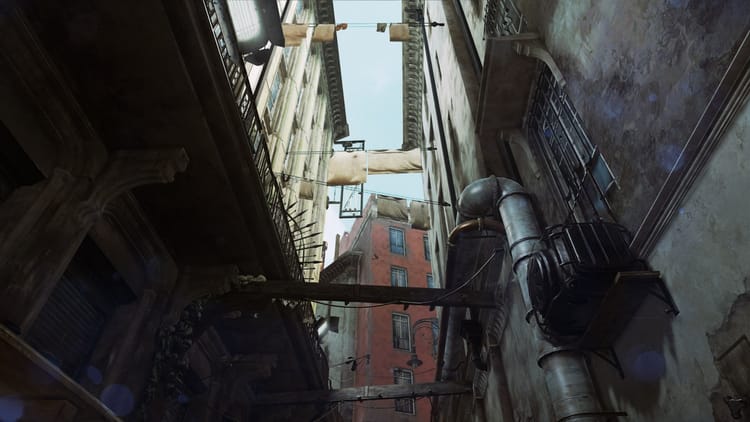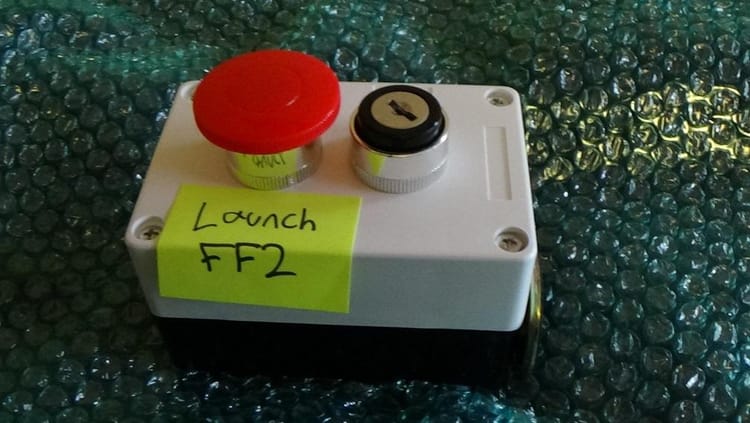Myst and the truth of objects

This article is part of our lead-up to Kill Screen Festival where Robyn and Rand Miller, creators of Myst, are keynote speakers.
///
Your job in Myst (1993) is to assemble books. Set aside for a moment the impossible grandeur, hermetic mythos, and resonant cultural legacy of the game and this is what you’re left with—red page, blue page. Eventually there’s a white page. These pages are objects. Any decent open-world game of the last few years will allow you to cart around hundreds of pounds of literature without slowing your upswing, because in these games, the books aren’t objects. They’re not even tools, like weapons or torches, which have weight and occupy space when you wield them. They’re information. But in Myst, where an entire completed volume is a sanctified, dimension-transcending treasure, you traverse great distances and surmount mighty obstacles to carry each page home one at a time, like exiled infants. There’s room for nothing else in your inventory: pick up the red page, you put down the blue one. In a rare moment of authorial magnanimity, there is even a menu option that is hard to imagine appearing in any other videogame—”Drop Page.”
The irony is that for all this focus on the palpable and concrete presence of books, there is very little information to be found anywhere. A cryptic note on the hillside, a mostly-charred library, and a handful of incomprehensible symbols are all you have to work with in the beginning. The rocket and the dentist chair sitting on either side of the library seem like the signatures of some absent author—but they aren’t talking. The books eventually do open up to you in a decidedly non-bookish way: insert the red or blue pages in the appropriately colored library volumes, and you get to watch (by way of portals stamped into the naked pages) a series of short films memorably starring creators Rand and Robyn Miller as the evil brothers Achenar and Sirrus.
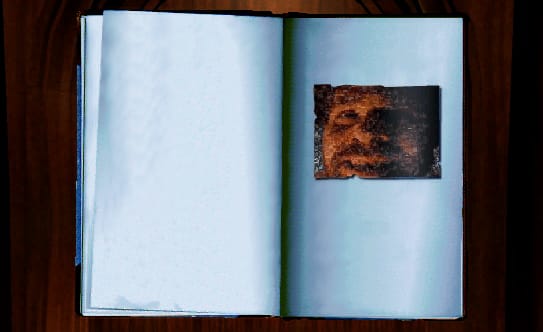
The decision to use video footage for the cinematic moments of the the game was, of course, a result of the technological limitations the Rand brothers were working with in the early 90s. Sequels would integrate motion capture technology and more advanced animation techniques. But the decision to put a movie inside a book inside a game is an aesthetic decision, and one completely of a piece with the ingeniously syncretic design of Myst. The Millers weren’t beholden to their technology; like great artists in every field, they make its shortcomings work in their favor. They affirm the blunt objective reality of each medium used to play the game—the static on the video screen, the CD-ROM icon that pops up during loading intervals, the weighty pages—as a reflection of the story’s focus on broken-down technology. It’s just one example of how, in this game, meaning isn’t derived from the acquisition of information or goal-directed catharsis; it arises from an engagement with the depths of objects.
In order to conduct their object-oriented symphony, the Millers had to dehumanize books as much as possible, depriving them of any privileged place in the plan of nature and scattering them in silence among their corporeal cohabitants. Scrape a page clean of text and all you have left is a dead tree. But you never really feel alone wandering through Myst’s quiet forests and forsaken fortresses, for the objects you encounter there—the rocket and dentist chair, the pumps, ball valves, telescopes, ladders, and lighthouses—speak their own language. There’s no glossary, but you have to learn it all the same if you want to get anywhere. This is why you are equipped with a hand instead of a cursor, arrow, or any other post-literary artifact of abstraction—acquaintance with an object is a strictly tactile affair.
the game disrupts any sense of acquaintance
Gripping and grasping my way back through the Ages of Myst in recent weeks, I was reminded of a distinction the philosopher Martin Heidegger makes between objects that are “ready-to-hand” (Zuhanden) and objects that are “present-at-hand” (Vorhanden). Ready-to-hand objects are the ones we encounter with an eye to their use: you don’t contemplate the design of your engine in the morning, you just want it to start. But if the engine doesn’t start because something breaks, it comes quickly to your attention—you now have this thing to deal with. In resisting your projection of a function onto it, the present-at-hand engine affirms its being as something fundamentally other.
For Heidegger, this jolt out of “everydayness” can lead to two outcomes. We can analyze the object’s properties and try to understand it better so that we can fix it and keep it inconspicuously churning in the future. This is the approach of technocratic capitalism, the reigning ideology of our time. The other approach is that of the artist, who is inspired by that initial defamiliarizing shock to perpetuate it with other materials and by artificial means. The artist’s true calling isn’t to portray objects the way everyone already sees them, but it isn’t to show us something new either; it is, paradoxically, to present what was already present as though we were seeing it for the first time.
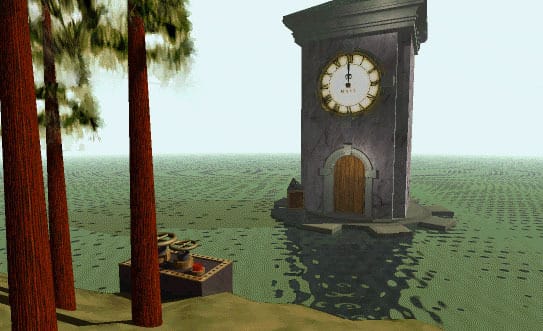
By this standard, Myst represents art of the highest order. Trans-dimensional portals aside, few of the objects you encounter in Myst are truly alien artifacts. In another context, or in another game, the rocket and the dentist chair might so befit the environment that you wouldn’t even give them a second glance. But by presenting them as broken-down, misplaced objects whose function doesn’t match their form, the game disrupts any sense of acquaintance before it can settle in as a veil over their essence.
This is why the world of Myst still, in 2016, feels more genuinely extraterrestrial than any number of more overtly fantastical (not to mention better-funded, better-staffed) studio creations. It’s true, of course, that some of these objects will eventually function as tools to be used in solving the game’s puzzles. Thus the hand cursor has two different modes, one for what is interactively ready and the other for what is merely present. But since, in this game, we never have a proverbial rug under our feet to begin with, there is no sense of security restored and no comfort regained when a puzzle is solved. There is only a kind of passing levity before we re-submit to the gravity of the tangible.
///
Myst has had a heavy burden to carry since the first weeks of its release. Here was a strange game about strange technology that made the technology it was made for mainstream for a decade. Here was a modest, quiet dream that sold six million copies and became a talking point for people who generally thought of games as things for kids to waste time on. In the apparently perennial conversation about whether games are truly Art, Myst has ever since been an essential reference point, like Ico (2001) or BioShock (2007) after it. But this kind of adulation has its downside, as Myst also became a favorite target for every new generation of game critics eager to kill its idols. This has led to a series of hyperbolic charges over the years—most infamously, Gamecenter‘s proclamation in 2000 that Myst “killed the adventure game.”
A better conversation might not dwell on whether games deserve their place in the pantheon of the arts, but which games deserve it. This requires choosing some basic criteria; without a set of requirements for what constitutes art, how could the debate be anything but interminable? Yet it is difficult for a critic to adumbrate criteria without implicitly privileging some subsection of the very works up for debate. One way out of this quandary is to really pay attention when universally recognized artists themselves try to define their craft, for even if their own definitions are selective, they can offer a perspective on creativity that critics by and large do not have.
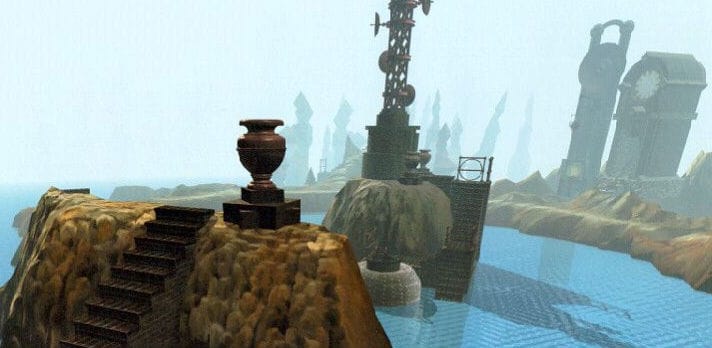
A few years ago, in honor of Myst‘s 20th anniversary, Emily Yoshida wrote a wonderful retrospective on the game for Grantland (RIP) that included an interview with Rand Miller. Yoshida took the opportunity to press Miller about a particularly arcane plot point that has little significance in the game itself, but huge ramifications for anyone trying to understand it. The issue concerns the game’s “linking books,” which contain the portals that allow for travel from Myst to the Ages and back. In the game, these linking books were written by Atrus, the father of Sirrus and Achenar, using “the Art” he inherited from the extraterrestrial wordsmiths on his father’s side of the family. Those with the Art are able to pass through their books and see the worlds they describe come to life. However—and this is the crucial point—they don’t actually create the worlds they enter; everything was the way it was before they wrote about it.
As Yoshida suggests, the implications of this point are fundamentally theological. A writer with the ability to write worlds into being is a kind of god; what is the writer who can perfectly describe a place they have no information about, and then go to that place? Do they actually have any power at all, or are they pawns in somebody else’s story? When Yoshida raises these issues, Miller has this to say:
“I’ll put it this way,” Rand said. “People ask me all the time if Myst was art. And I don’t even know what art is, so I’ve made up my own definition. I think Art with a capital A, for me, has this intent to communicate truth. Somehow you try to make something—you’ve gotten so good at what you do, you’ve become a master craftsman at what you do, that you can now try to communicate some kind of truth. And truth is a simple thing; it’s just, you know, something about the world around you, something about yourself.”
This apparently incongruous response is illuminating for a number of reasons. It is impossible, to begin with, not to make the connection between Miller’s “capital A” Art and the in-game Art that he and his brother devised. Indeed, Miller goes on to confirm that the decision to make the Art a non-creative power was a gesture of humility on the part of its meta-creators: “It’s good to stay a little bit humble with a powerful thing.” This explains why the objects chosen to populate Myst‘s landscape are mostly familiar ones from everyday life. Rand and Robyn Miller weren’t trying to show us anything new; they were unveiling the truth of objects we already thought we knew by simultaneously defamiliarizing and re-territorializing them.
you can’t put anything into words that didn’t already exist
Equally noteworthy is the way Miller defines the activity of the Artist. He speaks of becoming a “master craftsman,” a fashioner of objects, rather than using the language of—well, language. Miller says elsewhere in the interview that “we’re not game designers; we were place designers.” Hence they constructed the Ages and all their eccentric details first, and then let the environment dictate the contours of the story. This is perfectly in line with Miller’s aesthetic maxim; first you build something, and then you reorient the light so that truth shines through it. If the Millers had taken the traditional approach to building a narrative, letting the characters and plot dictate the details of the environment, then they would have been violating the prohibition that they imposed on their in-game personae: you can’t put anything into words that didn’t already exist.
If we don’t understand how these various dimensions of the game come together under the rubric of a universal respect for objects, then I think we miss the core of what makes Myst worth treasuring over two decades after its release. As a prime example of how easy it is to miss this mark, take the most high-profile game of recent years to be directly inspired by Myst—Jonathan Blow’s The Witness. Blow openly took inspiration from the design of Myst for his own obtuse puzzle game, hitting on all the major bullet points—abandoned island, strange objects, no interaction with anything living. But the puzzle objects in Blow’s game are geometrically rigid, artificial things positively reeking of intelligent design; Blow would rather invent an entire symbolic system of his own than find a way to let common objects speak. Where Rand Miller aspires to be a good craftsman, Blow openly compares himself to Thomas Pynchon, yet substitutes regurgitated information (in the form of pre-recorded quotations) for Pynchon’s gonzo inspiration. He puts in 15 minutes of a Tarkovsky film near the end just for the sake of doing so. Blow seems to think that the way to make a videogame a piece of art is to associate it as closely as possible with examples of great art in other media. It is startling that he doesn’t recognize what a disservice this does to his craft.
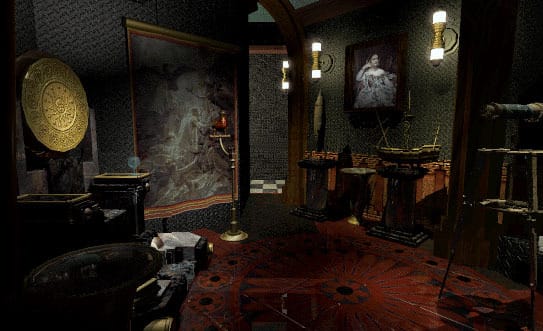
Videogames are not books. They aren’t paintings, films, or poems. To insist on evaluating their aesthetic worth by the criteria applied to other arts is to devalue what makes games, for all their diversity, singular. It ensures that they will always maintain the second-class position they once seemed born into, like television before The Sopranos (1999-2007) or pop before The Beatles. On the other hand, games have the potential to integrate all of these other arts in a way the latter can’t reciprocate, as Myst already demonstrated back in 1993 with its technological Matroyshka dolls. In theory, there could well be a Thomas Pynchon of the gaming world. But Pynchon didn’t build puzzles; he wrote words. Imagine a Pynchon successor as just one of hundreds of equally talented people working on a game, and you have some idea of the medium’s potential.
As the debate over games and art rages on, meanwhile, Rand and Robyn Miller are getting back to the business of making some. Obduction, the new project from their flagship company Cyan, is scheduled for release in June. The setup is similar to that of Myst: you come into contact with a strange object which instantly transports you to an alien world that, as the game’s website suggests, looks a bit like Kansas. Only this time, it isn’t a book that initiates the journey; the site describes it instead as simply a “curious organic artifact.” A living object, then, that wants nothing more than to transport you over the rainbow—imagine the stories its world has to tell.
///
To learn more about the Kill Screen Festival and register, visit the website.


